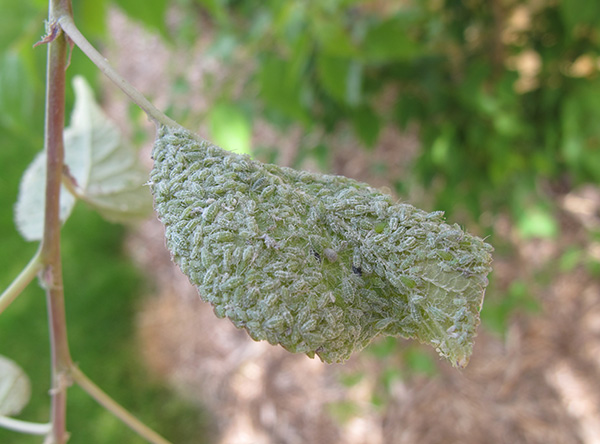Green Peach Aphid and Mealy Plum Aphid
FRUIT HOSTS
- Apricot
- Peach/Nectarine
- Plum
DESCRIPTION
Aphids are small, soft-bodied insects that often occur in clustered colonies. They suck sap from the phloem vessels in leaves and reduce tree vigor. Watch for curled and sticky leaves due to honeydew excreted by the aphids. Black sooty mold is a fungus that may grow on the honeydew staining the leaves and fruit.
BIOLOGY
Both green peach and mealy plum aphid species overwinter as eggs at the base of buds. Migrate to alternate hosts during summer. They hatch when the buds start to open and begin reproducing immediately. Aphids will feed on leaves until mid summer, or when they become overcrowded. They will then form wings and migrate to alternate hosts (weeds or grasses) for the rest of the summer. In September and October, they migrate back to the fruit trees to lay eggs.
SYMPTOMS
- Curled leaves
- Yellowed leaves
- Sticky honeydew
- Leaf drop
- Deformed fruit
MONITORING
Beginning at petal fall, inspect the undersides of leaves for new colonies. For faster inspection, shake limbs over a cloth tray (“beating tray”) to observe the dislodged insects.
TREATMENT THRESHOLD
Treat peaches when there are two or more colonies per tree before shuck split, or six or more colonies per tree after shuck split. Treat nectarines at one colony per tree at any time.
GENERAL MANAGEMENT
Numerous beneficial insects (e.g., lady beetles, lacewings, and syrphid flies) help suppress aphid populations, so conserve and protect these natural enemies. The backyard orchardist can usually ignore aphid infestations unless the populations are extremely high, growth of young trees is being stunted, or black sooty mold is staining the fruit. Apply a dormant spray of 2% oil at budbreak to kill eggs. During the growing season, insecticidal soap or 1% horticultural oil can suppress aphids.
INSECTICIDES
- Residential: insecticidal soap, horticultural mineral oil, azadirachtin, malathion, or pyrethrin
- Commercial: Click Here



